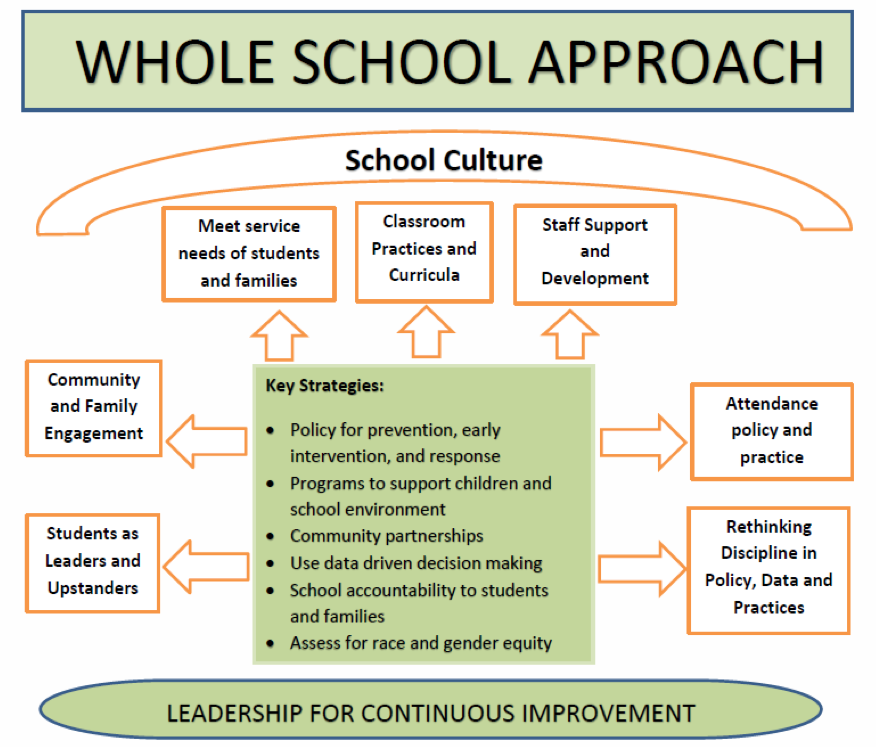The Whole School Approach
 A whole school approach
A whole school approach
is cohesive and collaborative action by a school community that is being strategically and continually constructed to improve student learning, behavior and wellbeing. Every school has different needs and starting points. The whole school approach is a framework that can be used to assess what exists, create a plan to address gaps and identify measures of progress. A whole school approach includes:
· An overarching supportive, safe and inclusive school culture
· School-based programs in and out of the classroom that focus on social emotional learning and respect for differences
· School policy that prioritizes, monitors and reports on progress for all students, with a focus on eliminating disparities
· School partnerships to bring community programs and resources into the school setting, to augment school capacity and address families’ needs beyond the classroom.
 The first step in whole school change is establishing a positive school climate and culture, which requires a collective and collaborative effort from the entire school community: teachers, administrators, staff at every level, parents and students. What is your school’s persona? Does it have a positive school culture and climate?
The first step in whole school change is establishing a positive school climate and culture, which requires a collective and collaborative effort from the entire school community: teachers, administrators, staff at every level, parents and students. What is your school’s persona? Does it have a positive school culture and climate?
“Positive learning can only take place in a positive culture. A healthy school culture will affect more student and teacher success than any other reform or school improvement effort currently being employed.” — Gary Phillips (www.schoolofeducators.com)
Developing and maintaining positive school culture is an important way for schools to improve their teaching and learning environments. As educational policies have shifted away from Zero Tolerance, a whole school approach to positive school climate, which includes Restorative Practices and Bullying Prevention, becomes even more essential to both the academic and emotional health of a school.
School climate reform leads to safer, more supportive, harmonious schools that allow children to be engaged and challenged. A growing number of agencies including the U.S. Department of Education, Centers for Disease Control and Prevention, and the Institute for Educational Sciences support school climate renewal. And national standards have been designed for content, leadership, ethics, family-school partnerships, and accreditation. Establishing a positive school culture requires leadership and a set of best practices. Here are some considerations when evaluating your school culture.
 A Vision for School Culture: How does your
A Vision for School Culture: How does your
school or district envision school culture? What are the expectations for success and what are the measureable actions you can take to achieve that?
- Commitment to Staff Support and Development: How is leadershiptaking care of staff so that they can take care of themselves and their students? What are your staff’s values and expectations? Is your model based on empathy, respect and generosity and creating opportunities for staff bonding?
- Relevant Classroom Practices and Curricula: How are you developing pro-social behaviors in students and the adults within the school? Are well sought out classroom curricula made available to teachers and are lessons embedded in coursework?
- Family and Community Engagement: Are parents included in your school culture? Are they invested? And are you modeling empathy, respect and generosity to the parents?
- Rethinking Discipline: Has your school moved away from Zero Tolerance disciplining policies? Are you using restorative practices to support student development?
- Meeting the Service Needs of Students and Families: Have you implemented steps to move social workers, guidance counselors, school wellness staff, home room teachers, deans and mentors into more proactive roles for teaching and working
with students?
- Solving Chronic Absenteeism: Are teachers provided the guidance and strategies to better manage, talk and work with all students including those who are chronically absent or late or requiring discipline or additional attention/supports?
- Utilizing Students as Leaders and Upstanders: Are student voices and concerns solicited and included? Is high engagement considered as much as high expectations? How well are staff supporting and offering opportunities for participation
by students in creating positive school climates?
Using a whole school approach to assess existing strengths and identify areas for improvement is effective in supporting change within schools at various stages and needs and supports a long term process.
Use these worksheets to assess what you have in place and where your needs are, in order to identify areas for improvement.

RESOURCES
- Creating Healthy Schools: Ten Key Ideas for the Social and Emotional Learning and School Climate Community
- Guiding Principles: A Resource Guide for Improving School Climate and Discipline
- Don’t Walk That Line! Why Schools Need to Create and Measure Positive Climates
- Why Social and Emotional Learning Is Essential for Students
- School Climate Practices for Implementation and Sustainability
- The Collaborative for Academic, Social, and Emotional Learning


